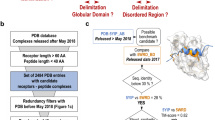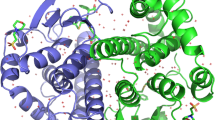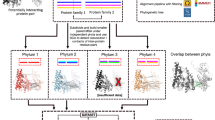Abstract
Prediction of protein-protein interactions at the structural level on the proteome scale is important because it allows prediction of protein function, helps drug discovery and takes steps toward genome-wide structural systems biology. We provide a protocol (termed PRISM, protein interactions by structural matching) for large-scale prediction of protein-protein interactions and assembly of protein complex structures. The method consists of two components: rigid-body structural comparisons of target proteins to known template protein-protein interfaces and flexible refinement using a docking energy function. The PRISM rationale follows our observation that globally different protein structures can interact via similar architectural motifs. PRISM predicts binding residues by using structural similarity and evolutionary conservation of putative binding residue 'hot spots'. Ultimately, PRISM could help to construct cellular pathways and functional, proteome-scale annotation. PRISM is implemented in Python and runs in a UNIX environment. The program accepts Protein Data Bank–formatted protein structures and is available at http://prism.ccbb.ku.edu.tr/prism_protocol/.
This is a preview of subscription content, access via your institution
Access options
Subscribe to this journal
Receive 12 print issues and online access
$259.00 per year
only $21.58 per issue
Buy this article
- Purchase on Springer Link
- Instant access to full article PDF
Prices may be subject to local taxes which are calculated during checkout



Similar content being viewed by others
References
Kleanthous, C. Protein-Protein Recognition: Frontiers in Molecular Biology (Oxford University Press, 2001).
Gavin, A.C. et al. Functional organization of the yeast proteome by systematic analysis of protein complexes. Nature 415, 141–147 (2002).
Uetz, P. et al. A comprehensive analysis of protein-protein interactions in Saccharomyces cerevisiae. Nature 403, 623–627 (2000).
Bader, G.D., Betel, D. & Hogue, C.W. BIND: the Biomolecular Interaction Network Database. Nucleic Acids Res. 31, 248–250 (2003).
Xenarios, I. et al. DIP, the Database of Interacting Proteins: a research tool for studying cellular networks of protein interactions. Nucleic Acids Res. 30, 303–305 (2002).
Berman, H.M. et al. The protein data bank. Nucleic Acids Res. 28, 235–242 (2000).
Bogan, A.A. & Thorn, K.S. Anatomy of hot spots in protein interfaces. J. Mol. Biol. 280, 1–9 (1998).
Pazos, F., Helmer-Citterich, M., Ausiello, G. & Valencia, A. Correlated mutations contain information about protein-protein interaction. J. Mol. Biol. 271, 511–523 (1997).
Andrusier, N., Mashiach, E., Nussinov, R. & Wolfson, H.J. Principles of flexible protein-protein docking. Proteins 73, 271–289 (2008).
Gray, J.J. High-resolution protein-protein docking. Curr. Opin. Struct. Biol. 16, 183–193 (2006).
Halperin, I., Ma, B., Wolfson, H. & Nussinov, R. Principles of docking: an overview of search algorithms and a guide to scoring functions. Proteins 47, 409–443 (2002).
de Vries, S.J., van Dijk, M. & Bonvin, A.M. The HADDOCK web server for data-driven biomolecular docking. Nat. Protoc. 5, 883–897 (2010).
Lesk, V.I. & Sternberg, M.J. 3D-Garden: a system for modelling protein-protein complexes based on conformational refinement of ensembles generated with the marching cubes algorithm. Bioinformatics 24, 1137–1144 (2008).
Cheng, T.M., Blundell, T.L. & Fernandez-Recio, J. pyDock: electrostatics and desolvation for effective scoring of rigid-body protein-protein docking. Proteins 68, 503–515 (2007).
Chen, R., Li, L. & Weng, Z. ZDOCK: an initial-stage protein-docking algorithm. Proteins 52, 80–87 (2003).
Schneidman-Duhovny, D., Inbar, Y., Nussinov, R. & Wolfson, H.J. PatchDock and SymmDock: servers for rigid and symmetric docking. Nucleic Acids Res. 33, W363–W367 (2005).
Caffrey, D.R., Somaroo, S., Hughes, J.D., Mintseris, J. & Huang, E.S. Are protein-protein interfaces more conserved in sequence than the rest of the protein surface? Protein Sci. 13, 190–202 (2004).
Keskin, O., Tsai, C.J., Wolfson, H. & Nussinov, R. A new, structurally nonredundant, diverse data set of protein-protein interfaces and its implications. Protein Sci. 13, 1043–1055 (2004).
Tsai, C.J., Lin, S.L., Wolfson, H.J. & Nussinov, R. A dataset of protein-protein interfaces generated with a sequence-order-independent comparison technique. J. Mol. Biol. 260, 604–620 (1996).
Tsai, C.J., Lin, S.L., Wolfson, H.J. & Nussinov, R. Protein-protein interfaces: architectures and interactions in protein-protein interfaces and in protein cores. Their similarities and differences. Crit. Rev. Biochem. Mol. Biol. 31, 127–152 (1996).
Keskin, O. & Nussinov, R. Similar binding sites and different partners: implications to shared proteins in cellular pathways. Structure 15, 341–354 (2007).
Aytuna, A.S., Gursoy, A. & Keskin, O. Prediction of protein-protein interactions by combining structure and sequence conservation in protein interfaces. Bioinformatics 21, 2850–2855 (2005).
Ogmen, U., Keskin, O., Aytuna, A.S., Nussinov, R. & Gursoy, A. PRISM: protein interactions by structural matching. Nucleic Acids Res. 33, W331–W336 (2005).
Keskin, O., Nussinov, R. & Gursoy, A. PRISM: protein-protein interaction prediction by structural matching. Methods Mol. Biol. 484, 505–521 (2008).
Kar, G., Gursoy, A. & Keskin, O. Human cancer protein-protein interaction network: a structural perspective. PLoS Comput. Biol. 5, e1000601 (2009).
Tuncbag, N., Kar, G., Gursoy, A., Keskin, O. & Nussinov, R. Towards inferring time dimensionality in protein-protein interaction networks by integrating structures: the p53 example. Mol. Biosyst. 5, 1770–1778 (2009).
Kar, G., Keskin, O., Gursoy, A. & Nussinov, R. Allostery and population shift in drug discovery. Curr. Opin. Pharmacol. 10, 715–7122 (2010).
Acuner Ozbabacan, S.E., Gursoy, A., Keskin, O. & Nussinov, R. Conformational ensembles, signal transduction and residue hot spots: application to drug discovery. Curr. Opin. Drug. Discov. Devel. 13, 527–537 (2010).
Keskin, O. & Nussinov, R. Favorable scaffolds: proteins with different sequence, structure and function may associate in similar ways. Protein Eng. Des. Sel. 18, 11–24 (2005).
Tuncbag, N., Gursoy, A., Guney, E., Nussinov, R. & Keskin, O. Architectures and functional coverage of protein-protein interfaces. J. Mol. Biol. 381, 785–802 (2008).
Shatsky, M., Nussinov, R. & Wolfson, H.J. A method for simultaneous alignment of multiple protein structures. Proteins 56, 143–156 (2004).
Mashiach, E., Nussinov, R. & Wolfson, H.J. FiberDock: flexible induced-fit backbone refinement in molecular docking. Proteins 78, 1503–1519 (2010).
Aloy, P. & Russell, R.B. Interrogating protein interaction networks through structural biology. Proc. Natl Acad. Sci. USA 99, 5896–5901 (2002).
Kundrotas, P.J., Lensink, M.F. & Alexov, E. Homology-based modeling of 3D structures of protein-protein complexes using alignments of modified sequence profiles. Int. J. Biol. Macromol. 43, 198–208 (2008).
Lu, L., Lu, H. & Skolnick, J. MULTIPROSPECTOR: an algorithm for the prediction of protein-protein interactions by multimeric threading. Proteins 49, 350–364 (2002).
Martin, J. Beauty is in the eye of the beholder: proteins can recognize binding sites of homologous proteins in more than one way. PLoS Comput. Biol. 6, e1000821 (2010).
Gunther, S., May, P., Hoppe, A., Frommel, C. & Preissner, R. Docking without docking: ISEARCH—prediction of interactions using known interfaces. Proteins 69, 839–844 (2007).
Sinha, R., Kundrotas, P.J. & Vakser, I.A. Docking by structural similarity at protein-protein interfaces. Proteins 78, 3235–3241 (2010).
Kundrotas, P.J. & Vakser, I.A. Accuracy of protein-protein binding sites in high-throughput template-based modeling. PLoS Comput. Biol. 6, e1000727 (2010).
Xie, L. & Bourne, P.E. Functional coverage of the human genome by existing structures, structural genomics targets, and homology models. PLoS Comput. Biol. 1, e31 (2005).
Xie, L., Xie, L. & Bourne, P.E. Structure-based systems biology for analyzing off-target binding. Curr. Opin. Struct. Biol. 21, 189–199 (2011).
Bradford, J.R. & Westhead, D.R. Improved prediction of protein-protein binding sites using a support vector machines approach. Bioinformatics 21, 1487–1494 (2005).
Liang, S., Zhang, C., Liu, S. & Zhou, Y. Protein binding site prediction using an empirical scoring function. Nucleic Acids Res. 34, 3698–3707 (2006).
Wells, J.A. Systematic mutational analyses of protein-protein interfaces. Methods Enzymol. 202, 390–411 (1991).
Pearson, W.R. & Lipman, D.J. Improved tools for biological sequence comparison. Proc. Natl Acad. Sci. USA 85, 2444–2448 (1988).
Hubbard, S.J. & Thornton, J.M. Naccess (Department of Biochemistry and Molecular Biology, University College, London, 1993).
Hwang, H., Pierce, B., Mintseris, J., Janin, J. & Weng, Z. Protein-protein docking benchmark version 3.0. Proteins 73, 705–709 (2008).
Tuncbag, N., Keskin, O. & Gursoy, A. HotPoint: hot spot prediction server for protein interfaces. Nucleic Acids Res. 38 (Suppl): W402–W406 (2010).
Tuncbag, N., Gursoy, A. & Keskin, O. Identification of computational hot spots in protein interfaces: combining solvent accessibility and inter-residue potentials improves the accuracy. Bioinformatics 25, 1513–1520 (2009).
Fischer, T.B. et al. The binding interface database (BID): a compilation of amino acid hot spots in protein interfaces. Bioinformatics 19, 1453–1454 (2003).
Thorn, K.S. & Bogan, A.A. ASEdb: a database of alanine mutations and their effects on the free energy of binding in protein interactions. Bioinformatics 17, 284–285 (2001).
MacKerell, A.D. et al. All-atom empirical potential for molecular modeling and dynamics studies of proteins. J. Phys. Chem. B 102, 3586–3616 (1998).
Acknowledgements
We thank all members of the Koc University Computational Systems Biology group, especially C. Ulubas, A. Selim Aytuna and U. Ogmen (former PRISM development team). We thank former and current members of the Tel Aviv University Structural Bioinformatics group, particularly M. Shatsky (MultiProt) and E. Mashiach (FiberDock). This work has been supported by TUBITAK (Research Grant numbers: 109T343 and 109E207). This project has been funded in whole or in part with federal funds from the National Cancer Institute, US National Institutes of Health (contract number HHSN261200800001E). The content of this publication does not necessarily reflect the views or policies of the Department of Health and Human Services, nor does mention of trade names, commercial products or organizations imply endorsement by the U.S. Government. This research was supported (in part) by the Intramural Research Program of the National Institutes of Health, National Cancer Institute, Center for Cancer Research. O.K. acknowledges support from the Turkish Academy of Sciences (TUBA).
Author information
Authors and Affiliations
Contributions
A.G. and O.K. developed the initial PRISM concept. N.T., A.G., R.N. and O.K. contributed substantially to the design and implementation of the current flexible PRISM. N.T. did coding and wrote the initial manuscript. All authors contributed substantially to the discussion of the results and to the writing of the paper.
Corresponding authors
Ethics declarations
Competing interests
The authors declare no competing financial interests.
Rights and permissions
About this article
Cite this article
Tuncbag, N., Gursoy, A., Nussinov, R. et al. Predicting protein-protein interactions on a proteome scale by matching evolutionary and structural similarities at interfaces using PRISM. Nat Protoc 6, 1341–1354 (2011). https://doi.org/10.1038/nprot.2011.367
Published:
Issue Date:
DOI: https://doi.org/10.1038/nprot.2011.367
This article is cited by
-
Identifying Lymph Node Metastasis-Related Factors in Breast Cancer Using Differential Modular and Mutational Structural Analysis
Interdisciplinary Sciences: Computational Life Sciences (2023)
-
Monoclonal antibody designed for SARS-nCoV-2 spike protein of receptor binding domain on antigenic targeted epitopes for inhibition to prevent viral entry
Molecular Diversity (2023)
-
Integrating protein copy numbers with interaction networks to quantify stoichiometry in clathrin-mediated endocytosis
Scientific Reports (2022)
-
Improved cytokine–receptor interaction prediction by exploiting the negative sample space
BMC Bioinformatics (2020)
-
PlaPPISite: a comprehensive resource for plant protein-protein interaction sites
BMC Plant Biology (2020)
Comments
By submitting a comment you agree to abide by our Terms and Community Guidelines. If you find something abusive or that does not comply with our terms or guidelines please flag it as inappropriate.



